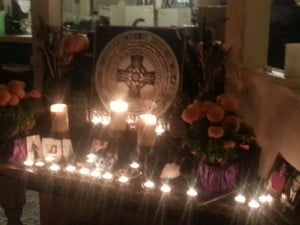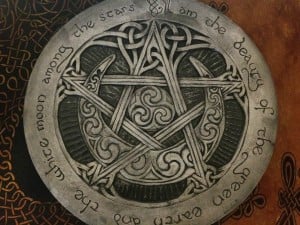ChristoPaganism is getting a lot of attention within our community, in part because it claims to combine two religious traditions considered irreconcilable. Does my analysis shed any useful light on the subject? From this perspective, what are we to make of ChristoPaganism?
At the level of spiritual practice, some ChristoPagans report powerful and moving spiritual experiences. I believe them. But what is ChristoPaganism’s relationship to Pagan and Christian religion? Is it identified with one story or the other, or with some other story?
Christianity has always defined itself against Pagan religions. It argues that personal salvation is needed and the only path to that salvation is through Jesus. Consequently, combining Christianity with Pagan religion seems to me more than problematic. Characters from one story can appear in another, as some Pagan characters appeared in C. S. Lewis’s Narnia stories. But Dionysus was not a character in a Pagan story; he was immersed in a different narrative. The same can happen in reverse. Jesus could become a part of a Pagan narrative. And from my perspective, he is welcome to join us.
As a Pagan, I have no trouble with someone or some group taking Jesus as the major focus of a ritual, as their spiritual teacher, or even as a spiritual force, and still identifying as Pagan. To be Pagan need not involve being critical of Jesus. The Roman Pagan Porphyry in his criticism of Christianity described Jesus very favorably, and even quotes an oracle of Hecate to that effect. In addition, myths from more than one Pagan culture describe human beings who became deities or tutelary spirits of high station. In myth, Dionysus’ mother was the mortal Semele who herself also ended up divine, and in every story I have read, the Africa Orisha Shango apparently began as a very powerful human. In Pagans and Christians, I wrote of an experience of my own that I suppose some might call “ChristoPagan,” though I would not (p. 212-14). On Witchvox, Ara Moonsong describes what she means by ChristoPagan, and her description seems completely within the Pagan story. In her practice, Jesus is a version of the dying and reborn God, she invokes Archangels into her circles, and she honors Mary as a Mother Goddess and Sophia as a Goddess of wisdom. For myself, I have no difficulty in considering her beliefs 100% within the Pagan story.
100%.
Can ChristoPagans go further?
If ChristoPagans seek to import major defining themes of Christian theology into this story, that is another matter. What is the meaning of Jesus’ death or of salvation or forgiveness of sins? Is there a fall? Pagans have no sense of a primordial fall, no sense of needing someone else’s self-sacrifice to relieve us from the guilt of our sin. Here the stories, and so the communities of practice they make possible, are incompatible.
Jesus as a divine or semi-divine figure can easily fit into a Pagan narrative. The theologies about Jesus that have arisen within Christianity cannot be so included because they were developed to make sense of the Christian story. I suppose some very liberal forms of Christianity could make this transition, but they will be so liberal most Christians will have difficulty granting they are Christian at all. In my opinion, their Christian critics will probably be right. Theologies can become detached from their stories, but at the costs of becoming detached from the laity.
If ChristoPagans seek to incorporate essential elements of the Christian story, the result is incoherence. For example, that an external redeemer/sacrifice is needed to bridge the otherwise insurmountable gap between people and the most sacred makes no sense in a Pagan context. That there is only one way to accomplish this goal makes no sense in a Pagan context. That only the killing of a being embodying perfect innocence enables all the less-than-innocent for all time to be saved from a horrible and deserved fate makes no sense in a Pagan context. That believing an event that happened so long ago has any bearing at all on one’s ultimate status spiritually makes no sense within a Pagan context.
The closest Pagan practice I know of that approaches this model is sacrificing a person or animal. The being is honored and is doing this willingly (or not) for the good of the community that actually and quite deliberately does the sacrifice. A great many agricultural Pagan societies practiced human sacrifice at one time or another. Most gave up this practice on their own. But it has existed.
The Christian story of human sacrifice links in some ways with Pagan traditions that also practiced it, but reorganizes their thinking in a way that no longer fits a Pagan outlook. Elements found in one story exist in the other, but in a context that transforms them. For example, unlike in Pagan communities, the community did not intend to make a sacrifice (“Forgive them, for they know not what they do”), and the sacrifice supposedly helps people who are not part of that community, people who will not even exist for thousands of years. Once we start looking at essential elements of the Christian and Pagan stories, they cannot coherently exist as equals in a common narrative.
The logic of story
I am using the ChristoPagan example to deepen our understanding of how helpful the two-dimensional definitional scheme of story and taxonomy and story and theology can be.
Basic stories are like gravitational fields around which various narratives develop. Their elements can be quite diverse and still contribute to a coherent pattern, as there can be different historical novels all of which are historical novels and not biographies.
Think of a community trying to make use of essential elements of two very different stories. There might be some kind of balance between them that works at a personal level, because the coherence arises from within a person’s spirituality, from what cannot be put into words. But the community cannot long remain in this balance because it is made up of people who understand these elements in different ways, and as they discuss these issues, sooner or later will seek greater coherence in the story. The only way to do so will be to give greater weight to one or the other, making one story the core theme and the other a subsidiary element. Alternatively, they might develop a third story that is neither Christian nor Pagan. My guess is that such a story would resemble Gnosticism. But that is not my problem.
If I am correct, I predict any attempt to create a religion of ChristoPaganism that is not itself simply another form of Paganism will rapidly turn into another form of Christianity, become a third religion, or collapse into incoherence and become what it already is for some: a purely personal spiritual perspective.
If this is a valid perspective, not just any framework will work for a religion. The religion depends on a story, and the theologies that give more precise meanings to the religion arise from and are dependent on it. There is a Pagan story, and within Paganism there are other stories that are more concrete descriptions of the basic theme. Thus Voudon, Gardnerian Wicca, and Lakota religion have different characters, different rituals, in many ways different mythologies, but all are examples of the Pagan story, each with their own more detailed coherence that makes sense to practitioners.
While our spiritual lives are often far more complex that any story, as soon as we begin trying to get others to join with us, and seek to create a tradition we move from the world of inner understanding to the outer world of verbal communication. We then need to find enough cohesion to work or worship or celebrate effectively together. If a story cannot make sense, it cannot serve as the scaffolding around which a religious community builds their practices. It is as if its architects and builders are working with incompatible blueprints that describe different buildings, but are seeking to erect a common structure on the same ground.
Over time all religions diversify as their basic stories are elaborated in different ways by different groups. NeoPaganism is not at all unusual in this regard except perhaps in the rapid growth of ‘traditions,’ because we are developing without being rooted in a single dominant tradition. British Traditional Wicca was sort of an initial template, but for various reasons it fragmented fairly quickly into different approaches. Cecause many came to what is now called Wicca independently of established lineages, the Wiccan tradition quickly diversified beyond the basic BTW framework. But in all this divergence there remains not just a common Pagan story, but for most a more focused common Wiccan story captured by our celebration of Sabbats and Esbats and by the almost as frequent focus on sexual dualism embodied in God and Goddess.
But when the overarching unifying vision of a Pagan or other story is absent, then there is nothing to provide a more abstract unity for the practitioners. The inevitable diversification loses all form, as it ceases to be a religion and becomes instead part of different people’s spiritual understanding.
What does this mean about religious toleration?
If past a certain point, stories are not able to blend into one another, some readers might worry that I am providing a potential justification for religious intolerance. If so, they misread me. The most important point is not that stories are different but that stories are partial. No story has it all, and for most of us I suggest no story does full credit to our personal spirituality. Religions are social, not personal. They can deeply enrich our spiritual lives, or they can stifle and impoverish them. Either way, they are not the same as our spirituality. There is nothing in the logic of my argument that suggests one religion is better for everyone or anyone.
The analogy I want to make here is with a loving relationship. Marriage laws are the social form by which our society recognizes and legally privileges certain loving relationships. But people can be in loving relationships whether they are married or not, and they can be in loveless relationships, whether married or not. Either way, it is the loving relationship that hopefully matters most, and it is an additional blessing when society accepts and recognizes the value and worth of your relationship by enabling it to be recognized as marriage.
At the same time, people in one loving relationship and marriage do not look down on people in different loving relationships and marriages.
The same observation applies to religions. A person’s love for their religion has no relevance at all to whether a different person has love for a different religion. That I love mine no more warrants me to criticize a different religion than the fact that I love one person gives me warrant to criticize others who love different people.
The logic of my argument points to a principled endorsement of toleration. My final section of this series will take that argument a step farther: that we should celebrate our differences while continuing to honor who we are.













